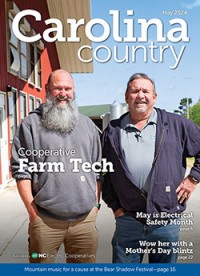Working Together for a Reliable Grid
Electric co-ops are meeting the changing needs of our members
Across the state and the entire country, the need for power is growing. Businesses and manufacturing are thriving. New, efficient technology — like electric vehicles (EVs) and electric heating and cooling systems — are becoming more accessible, and renewable energy and battery storage are growing. These are all good things — good things prompting significant changes in how and where electricity is generated, managed and yes, even consumed.
There is no “business as usual” in the electric utility industry, which has experienced predictability and a tried-and-true operating structure for decades. These big changes are prompting concerns about electric reliability from power grid watchdog groups, which I discussed in a column last summer (“Safeguarding Reliable Power,”) and the topic is often covered in the media.
It’s also top-of-mind for consumers, with 87% of electric cooperative members in North Carolina expressing concern about grid reliability, according to the 2023 National Survey on the Cooperative Difference.
But despite these big changes and the concerns they prompt, one thing that’s certain is our commitment to working ahead of these complexities to provide you with reliable and affordable power. North Carolina’s electric cooperatives are working together and are investing in technologies that support our evolving grid.
First, we are developing new programs and partnerships to manage grid resources more efficiently. These include coordination both within the electric co-op network and with other electric utilities to ensure demand is met across the entire power grid. On the consumer side, innovative programs enable co-ops to work directly with members to manage devices like water heaters and smart thermostats, reducing energy use when it’s most needed.
Electric co-ops are stepping up to meet the changing needs of our members.
Second, North Carolina’s electric co-ops are adding resources to increase available power while supporting our goal of net-zero carbon dioxide emissions by 2050. Recent examples include plans to partner with Duke Energy on its proposed hydrogen-capable natural gas plant in Person County (see page 6), as well as new renewable sources like solar + storage sites across the state, and additional energy storage projects at co-op substations.
Third, co-ops are focused on the future. We’re exploring and implementing concepts such as microgrids to further enhance local reliability. We’re also exploring the responsible use of artificial intelligence to improve forecasting that accounts for new technology trends — like widespread use of electric heat pumps — to help predict when demand will be high. And we’re storm-hardening systems, ensuring grid components work as they should and can operate at full capacity when needed.
The bottom line is electric co-ops aren’t doing business as usual. As we’ve done since the early days of rural electrification, we’re stepping up to meet the changing needs of our members, whether that means welcoming new electric load in homes, businesses and on farms across the state, or supporting economic development that can energize rural communities.
We’re approaching these and other initiatives with an overall strategy to ensure a brighter future — a reliable future — for North Carolina’s rural people and the communities we call home.
-
Reliability is our mission
-
Share this story:







